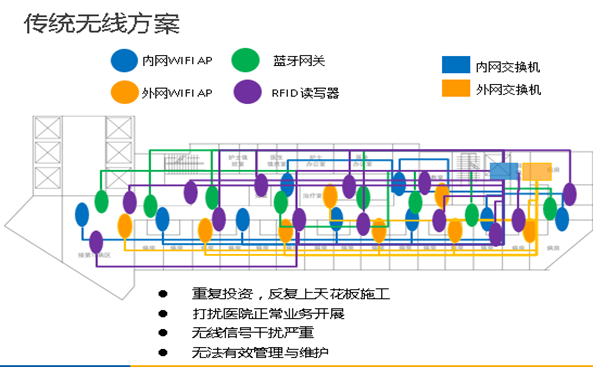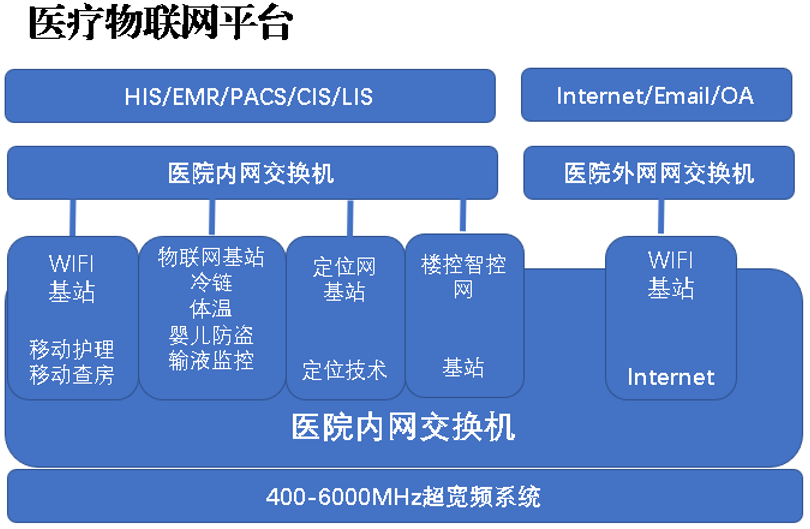Click the blue text to follow us
Establishing an IoT platform for hospitals to improve work efficiency. Through a unified, highly integrated IoT platform, various application functions can be presented, used, and managed based on the same platform, while establishing application functions that meet the specific needs of various departments in the hospital, allowing each application function to effectively play its role. This improves hospital work efficiency and enables data sharing and interoperability with the hospital’s existing information systems. By establishing a medical IoT platform, the issues caused by the chaotic construction of the hospital’s wireless network, such as mutual interference and repeated cabling, are resolved, achieving the effect of covering the hospital with a single network.
Introduction
Hospitals have many medical wireless intranet data applications, IoT mobile applications, and external/public network App applications. If the wireless network is built in a chaotic manner, it will inevitably cause mutual interference between systems (Figure 1). For example, there are various external wireless WiFi products, including those from three major operators and self-built hospital external App projects, which interfere with each other and also seriously disrupt the use of the internal wireless network. Another issue with chaotic construction is that various mobile application systems repeatedly pull wires in the ceiling, wasting resources, and each system installs its own wireless base station in the ceiling, leading to a higher failure rate of active devices like base stations and increasing the management and maintenance costs for the hospital. Additionally, the ceiling in patient areas is an open environment, where various maintenance workers can access, exposing the hospital’s internal network switch ports in public areas, making them vulnerable to tampering and eavesdropping, posing a serious threat to the security of the hospital’s internal network data. Frequent lifting of the ceiling, whether for cabling or maintenance, disrupts the normal operation of daily medical services and increases the risk of hospital infections.

System Design and Implementation
Design Goals The construction of the medical IoT platform mainly solves three core issues: first, to provide a unified IoT base station, with various IoT applications such as temperature monitoring, infusion monitoring, cold chain management, and wireless analgesia pumps. Each application requires a different IoT base station due to different communication frequencies and protocols, leading to the need for multiple base stations. A unified IoT base station can reduce the number of base stations purchased, lowering procurement and management costs. Second, it provides a unified data engine service for various medical IoT applications, obtaining real-time data uploaded by IoT sensors, solving data interaction between various medical IoT application systems and the hospital HIS, integrating data with various medical application systems through standard communication protocols such as HL7 and RESTFUL API, ensuring that real-time sensed data from IoT sensors can interact and collaborate with clinical information systems based on workflow integration, thus assisting in completing various tasks in a digital form. Third, it actively monitors the working status of IoT base stations, smart sensors, positioning antennas, navigation antennas, etc., analyzes the health index of the IoT system operation, and provides data support for the hospital to further optimize the IoT.
Structure Design of the IoT Platform
Structure Design The integrated management platform adopts a three-layer structure design, namely IoT base station, data engine, and operation and maintenance platform. The IoT base station uses network-based management, supporting web technology, allowing all integrated information to be browsed in a networked environment via a browser. The data engine is a software module running on a server, corresponding to various data transmission and reception functions achieved by the IoT base station and smart sensors, smart terminals.
Compatibility The design of the medical IoT system integrated management platform supports frequency bands from 400 to 6000 MHz, allowing future integration of all IoT smart terminals and application systems in the hospital, and it can also be compatible with other IoT application systems without needing to build a separate network.
Scalability Hospitals have various information systems, some of which are older legacy systems, while others use new technologies. The interfaces provided by each system are different, so the integration platform should support multiple communication protocols and message protocols. For communication protocols, examples include COM, WebService, CORBA, database tables or views, stored procedures, FTP, TCP/IP, etc.; for message protocols, HL7 and some custom fixed-format texts, such as customized XML, are used. At the same time, the integration platform can open network interface standards to achieve automatic data transmission with third-party systems and can provide secondary development interfaces to achieve data interaction as required by the hospital while ensuring secure data transmission.
Unity The construction of the medical IoT takes a strategy of unified planning and distributed implementation, following this route: at the data level, the system can achieve data sharing and interoperability with various existing information systems in the hospital such as HIS, LIS, PACS (Figure 2).

In this platform (Figure 3), resource centralization and scaling can be achieved, enabling compatibility with various heterogeneous software and hardware foundational resources and dynamic resource flow, while dispatching static and fixed hardware resources to form a resource pool. Additionally, it is necessary to process information and business, extracting useful parts from massive data, monitoring and managing large-scale foundational software and hardware resources, providing decision-making information for various subsystems at the application layer, which is the main data source for the business layer.

Application Effects of the Medical IoT Platform
By building an ultra-wideband indoor signal distribution system, multiple medical wireless applications can be simultaneously met, from WLAN wireless data networks to WMTS medical private networks, from medical positioning networks to medical IoT, while supporting multiple RF frequencies from UHF band to 5.8GHz, and supporting N wireless communication protocols, including 802.11a/b/g/n/ac, proprietary RFID protocols, ZigBee, BLE, WMTS, and commercial 3G/4G/5G protocols. This avoids repeated construction, simplifies the wireless network system architecture, and reduces overall ownership and maintenance costs.
By building a medical IoT platform, hospitals can orderly introduce various medical wireless applications. For example, if a hospital wants to carry out mobile rounds and mobile nursing applications, it only needs to add a base station that supports WiFi protocol in the weak current room on each floor, so that every corner of the patient area can receive a high signal-to-noise ratio WiFi signal. Nurses can use PDAs while moving around the patient area, and the PDA will always connect to the same base station in the weak current room. Since the wireless signal seamlessly covers, the PDA can easily achieve zero roaming, zero switching, and zero packet loss, ensuring continuous and stable communication. For doctors’ rounds, since downloading PACS images requires bandwidth, as long as the base station in the weak current room supports 802.11ac, this protocol’s communication rate is high, and with no interference in the entire environment, the bandwidth will be sufficient to meet the doctors’ needs for accessing PACS.
To carry out IoT applications, such as temperature monitoring systems, it is only necessary to add a base station that supports temperature monitoring in the weak current room on the target floor, without the need for additional cabling. Through the medical IoT platform, every corner of the patient area can receive signals from the temperature collection system. If an infusion monitoring system is added, similarly, a base station that supports infusion monitoring can be added in the weak current room on the floor, without additional cabling, and every corner of the patient area can receive signals from the infusion monitoring system. If the hospital is dissatisfied with the internal network bandwidth, it can upgrade the internal network base station or add another internal network base station, allowing linear bandwidth expansion. Two internal network base stations can also be used for redundant hot backup, further ensuring network stability in critical areas such as operating rooms, ICUs/CCUs. If the hospital wants to carry out wireless external network services, it can also add corresponding base stations in the weak current room on each floor, such as a base station that supports external network video on demand or an external network App base station. These external network base stations are completely independent from the internal network base stations, with no shared active components, thus representing a strict physical separation.
Hospitals can also connect building intelligence control systems, security intercom systems, etc., to the medical IoT platform, and even request operators to pay to connect 3G/4G and future 5G networks to the medical IoT platform.
Conclusion
By establishing a medical IoT platform, the chaotic situation caused by the previous chaotic construction of the hospital’s wireless network, which led to mutual interference between wireless network systems, wasted resources from repeated cabling, increased management and maintenance difficulties and costs, and frequently disturbed normal medical operations has been resolved, achieving the effect of covering the hospital with a single network.